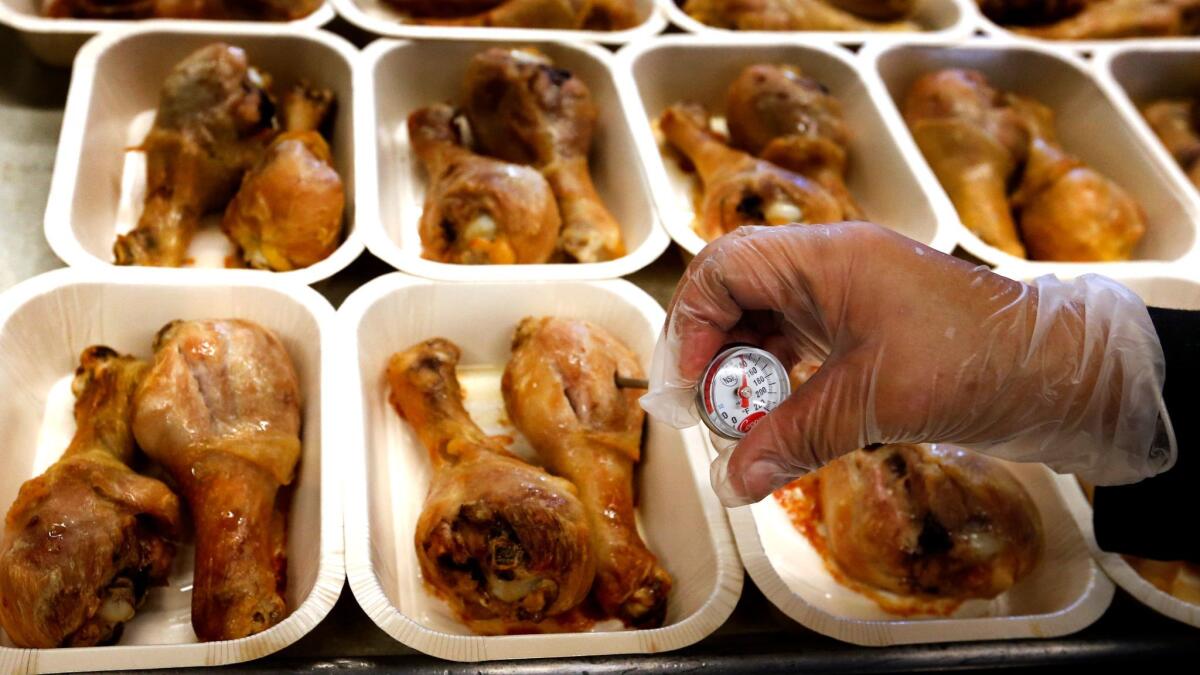Chicken nearly disappeared from L.A. school lunches. Now, it’s making a comeback

Chicken will soon be making a comeback to school menus across L.A. (April 13, 2017) (Sign up for our free video newsletter here http://bit.ly/2n6VKPR)
For more than a year, one of the foods Los Angeles students like best has been all but absent from school menus.
Last month, high school students, with two entree choices at lunch, were offered an oven-baked drumstick on the 24th — but that was it for chicken.
Los Angeles Unified School District had been budgeting up to $20 million on chicken a year. Then its school board set new standards for how suppliers should treat their poultry, their workers and the environment. Contract talks with Tyson Foods and Pilgrim’s Pride, the nation’s largest two suppliers, fell apart in 2015.
This month, the Board of Education finally cleared the way for a chicken comeback, approving contracts with three new vendors — including powerhouse Perdue Farms — that more closely meet its criteria. As soon as May, students should see the return of chicken frankfurters, patties and tenders.
Food advocates say the nation’s second-largest school system led the way with standards for food suppliers.
“The district has done a good job and they have the commitment,” said Clare Fox, executive director of the Los Angeles Food Policy Council, which advises and evaluates local institutions on food purchases.

Still, some observers question such attention to wings and thighs in a school system struggling with below-average test scores and a potential budget crisis.
Accounts of just what caused the standoff differ.
L.A. Unified’s negotiator said a major sticking point was the district’s insistence on a right to audit company operations. A Tyson spokesman recalled a disagreement over price.
The two versions are not entirely at odds, given that stricter requirements can drive up the price of a product. Pilgrim’s Pride said it simply decided to pursue other business opportunities.
After negotiations collapsed, turkey showed up more frequently on district menus. In the interim, distributor Gold Star Foods, which does not raise its own chickens, was able to provide only a limited supply.
The origins of the chicken crisis date to 2010, when Tyson was the finalist for the primary, five-year chicken contract. When the contract came before the Board of Education, school board member Steve Zimmer said he’d heard that Tyson had a poor reputation. As Zimmer recalls it, a senior staffer then assured him that the company’s problems were in the past. Zimmer immediately searched the Internet, found evidence of ongoing concerns, including worker safety, and turned his laptop screen around to let people see what he’d found.
He got the vote delayed and also won over two colleagues on the seven-member board. But a four-vote majority approved the contract.
“It was fairly heartbreaking for me,” Zimmer said.

The rest of the Board of Education had come around by 2012, when L.A. Unified may have been the nation’s first school system to adopt rules to evaluate food suppliers in five areas: the nutritional quality of their products, animal welfare, environmental impact, help to the local economy and treatment of the workforce.
Early on, the district had success, such as expanding the purchase of locally grown produce. But the 2015 chicken contract was seen as a watershed. Activists and some prosecutors had targeted Big Poultry, with its massive farms and slaughterhouses, accusing companies of polluting the environment, exposing workers to danger and treating chickens in a needlessly inhumane manner. Some of their practices were secretly filmed.
“Every big issue you see connected to the food system is manifested, is most dramatic, in the chicken industry,” said Alexa Delwiche, executive director of the Berkeley-based Center for Good Food Purchasing, which helps large institutions monitor and improve food procurement practices.
In recent years, consumers, distributors and institutions have exerted increasing pressure on suppliers to move away from feeding chickens with meal made from meat byproducts and from pumping them with antibiotics. Scientists have said the use of antibiotics in farming could hasten the evolution of disease-resistant bacteria.
In 2016, fast-food giant McDonald’s announced that it would no longer purchase chickens that received any antibiotic used to treat people.
L.A. Unified, meanwhile, helped build a consortium of the nation’s six largest school systems to strengthen their clout with food providers. And last year, San Francisco and Oakland Unified passed their own versions of L.A.’s good-food policy.
The school system has a long history of activism. It supported divestment from apartheid South Africa, used school construction bonds to pay for a local job-training program, and led the pack on paying a $15-an-hour minimum wage and providing health benefits to part-time workers and their families.
As with some other stands, the poultry principles come with a price — the potential to make chicken as much as two-thirds more expensive, according to an estimate last year by a senior manager in food services.
“While examining the nutritional health of food products is worthwhile,” said Lance Izumi, an education specialist at the conservative, San Francisco-based Pacific Research Institute, “one wonders why the school board is spending so much time promoting a social-activist agenda in its cafeterias rather than focusing on improving the poor achievement of so many district students.”
Criticism on this front recently entered the school board campaign in a negative mailer illustrated with photos of chicken nuggets that targeted Zimmer.
But on this issue, Zimmer and Nick Melvoin, his opponent in a May runoff election, virtually finish each other’s sentences.
“When companies like Tyson Foods are cited repeatedly for [Occupational Safety and Health Administration] violations, poor working conditions and failure to meet sustainability standards, they must be held accountable and new providers must be sought,” said Melvoin when he answered questions posed by the nonprofit Los Angeles Food Policy Council. “The only way to do that is through oversight — which is the responsibility of the LAUSD board, and what I’m running to promote.”
Zimmer said his job takes in the whole district, not just academics.
“This is not ever what I thought I would spend a minute on,” Zimmer said. “But we have a major responsibility in managing a $7.6-billion operating budget and the impact of those funds on what will be, for some students, their only full meal of the day. And also on the impact of these dollars on the lives of the people who work in these industries.”
In March, to begin to bring chicken back, the district approved up to $50 million in contracts over five years with Perdue, Goodman Food Products and Somma Food Group, and additional spending is likely.
The incoming chicken, per district rules, has to be antibiotic-free. Perdue, as it happens, now proclaims all its chickens free from hormones, steroids and antibiotics. All chickens, Perdue says, also enjoy “a 100% vegetarian diet” — and drink oregano-spiked water as an antioxidant.
As for Tyson and Pilgrim’s Pride, they may try to get back in.
“Many of our products meet L.A. Unified’s Good Food Purchasing Policy standards,” said Pilgrim’s spokesman Cameron Bruett. “We believe there will be opportunities to do business with each other again in the future.”
Tyson also has products that meet the district’s standards, said Tyson spokesman Gary Mickelson: “We’re proud of our company and strive to operate responsibly in all aspects of our business.”
The district has yet to apply its full standards to beef and pork, although that’s the plan. Even with chicken, the new suppliers don’t score well across all parameters, Zimmer said.
And the hunt continues for a good breakfast biscuit with chicken.
Still, the patties and tenders should please hungry students.
“We do a lot of taste tests,” said L.A. Unified Food Services Director Joseph K. Vaughn. “It became very apparent to us that the kids want breaded chicken product.”
Twitter: @howardblume
ALSO
California and L.A. Unified graduation rates continue to increase
New coalition pushes for one enrollment system in L.A. Unified
Charter schools are expanding where they aren’t needed — especially in Los Angeles, new report says
More to Read
Sign up for Essential California
The most important California stories and recommendations in your inbox every morning.
You may occasionally receive promotional content from the Los Angeles Times.











